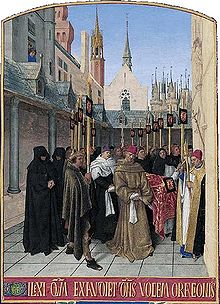Office of the Dead

The Office of the Dead or Office for the Dead (in Latin, Officium Defunctorum) is a prayer cycle of the
.In the postconciliar form
The current form, according to the 2000 Liturgia Horaria (
In the preconciliar form
This office, as it exists in the Roman Rite up to and including the current 1960 Roman Breviary, is composed of First Vespers, Mass, Matins, and Lauds. The editor is not known, but the office as it existed before the alternative was no older than from 7th or 8th century. A well-known refrain from the cycle is Timor mortis conturbat me, "The fear of death disturbs me" or, more colloquially, "I am scared to death of dying". The word dirge comes from the cycle.
The Vespers of the older form of the office comprise Psalms
The "Libera me de morte æterna", which is found more complete in the ancient manuscripts, dates also from an early period (see Cabrol in "Dict. d'archéol. et de liturgie", s. v. Absoute). Pierre Batiffol remarks that it is not of Roman origin, but it is very ancient (Hist. du brév., 148). The distinctive character of the Mass, its various epistles, its tract, its offertory in the form of a prayer, the communion (like the offertory) with versicles, according to the ancient custom, and the sequence "Dies Iræ" (q.v.; concerning its author see also BURIAL), it is impossible to dwell upon here. The omission of the Alleluia, and the kiss of peace is also characteristic of this mass. There was a time when the Alleluia was one of the chants customary at funeral services (see Dict. d'archéol. et de liturgie, s. v. Alleluia, I, 1235). Later it was looked upon exclusively as a song of joy, and was omitted on days of penance (e.g. Lent and ember week), sometimes in Advent, and at all funeral ceremonies. It is replaced today by a tract. A treatise of the 8th-9th century published by Muratori (Liturg. Rom. vet., II, 391) shows that the Alleluia was then suppressed. The omission of the kiss of peace at Mass is probably because that ceremony preceded the distribution of the Eucharist to the faithful and was a preparation for it, so, as communion is not given at the Mass for the Dead, the kiss of peace was suppressed.
Not to speak of the variety of ceremonies of the Mozarabic, Ambrosian, or
Notably, the
History

The Office of the Dead has been attributed at times to
The Gregorian Antiphonary contains a mass and an office in agenda mortuorum, but it is admitted that this part is an addition; a fortiori this applies to the Gelasian. The Maurist editors of St. Gregory are inclined to attribute their composition to Albinus and Etienne of Liège (Microl., lx). But if it is impossible to trace the office and the mass in their actual form beyond the 9th or 8th century, it is notwithstanding certain that the prayers and a service for the dead existed long before that time. They appear in the 5th, 4th, and even in the 3rd and 2nd century. Pseudo-Dionysius, Sts. Gregory of Nyssa, Jerome, and Augustine, Tertullian, and the inscriptions in the catacombs afford a proof of this (see Burial, III, 76; PRAYERS FOR THE DEAD; Cabrol, "La prière pour les morts" in "Rev. d'apologétique", 15 September 1909, pp. 881–93).
Practice and obligation
The Office of the Dead was composed originally to satisfy private devotion to the dead, and at first had no official character. Even in the 11th, 12th, and 13th centuries, it was recited chiefly by the religious orders (the Cluniacs, Cistercians, Carthusians), like the
Indulgence
In the ancient rite of the Roman Catholic Church, with
The 2004
References
- ^ ISBN 0802824161. Retrieved 1 November 2012.
Lutheran and Anglican revisions retained the form of the Office of the Dead from the monastic breviaries with its psalms and traditional texts, such as the In media vita (In the midst of life [we are in death]).
- ^ Batiffol, "Hist. du Brév.", 181-9
- ^ "De Eccles. officiis", IV, xlii, in P. L., CV, 1238
- ^ Bäumer-Biron, "Hist. du Brév.", II, 37
- ^ Cabrol, "Dict. d'archéol. et de liturgie"
- ^ Canzani Amedeo (1826). Breve istruzione sopra le ecclesiatiche indulgenze in generale e sopra il giubbileo [Brief instruction on ecclesiastical indulgences in general and on the jubilee] (in Italian). typografia Andreola editrice. p. 67.
- ^ Enchiridion Indulgentiarum.quarto editur, Concessiones, 29 §2 2°
External links
- A complete office of the dead from Google Books
- Hypertext Book of Hours - Contains the Western Office of the Dead.
 This article incorporates text from a publication now in the public domain: Herbermann, Charles, ed. (1913). "Office of the Dead". Catholic Encyclopedia. New York: Robert Appleton Company.
This article incorporates text from a publication now in the public domain: Herbermann, Charles, ed. (1913). "Office of the Dead". Catholic Encyclopedia. New York: Robert Appleton Company.
